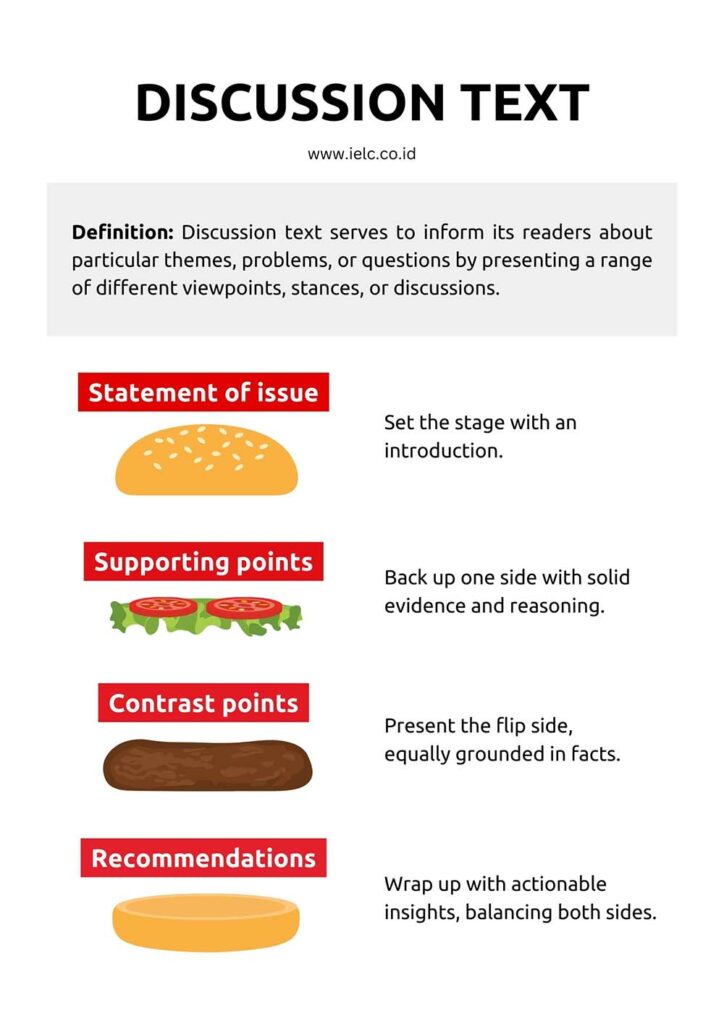
Discussion text: definition, structure, and example
Hello, English learners!
Hope you’re doing well and still excited to take a deep dive into the world of English!
Today, we are going to learn all about discussion text!

What is a discussion text?
Imagine you and your friends are chatting about a topic, and each of you has a different perspective or opinion.
A discussion text is like that conversation written down!
It’s all about presenting various viewpoints and arguments, so that readers can understand the different aspects and make their own informed decisions.
Usually, a discussion text starts with an introduction to the topic, followed by the presentation of different perspectives. Each viewpoint is supported by reasons and evidence, and the writer often wraps things up with a conclusion that summarizes the discussion and may even offer a personal opinion.
What are the purposes of a discussion text?
- Inform: A discussion text aims to inform readers about a particular topic, issue, or question by presenting different perspectives, opinions, or arguments.
- Encourage critical thinking: By exploring various viewpoints, discussion texts encourage readers to think critically, analyze different perspectives, and develop their own opinions.
- Stimulate debate: By presenting contrasting ideas, discussion texts can spark conversations and debates among readers, fostering a deeper understanding of the issue at hand.
What are the characteristics of a discussion text?
1. Thinking verbs
These verbs describe mental processes or cognitive actions, such as thinking, believing, understanding, considering, or assuming. They can be employed in a discussion text to present the thoughts or opinions of the writer, experts, or others involved in the debate.
Example: Many believe that the government should invest more in renewable energy.
2. Modal verbs
Modal verbs (such as can, could, may, might, will, would, shall, should, must) express possibility, probability, necessity, or obligation. They can be used in discussion texts to indicate the level of certainty or commitment to a particular viewpoint.
Example: Parents should encourage their children to read more books.
3. Adverbs of manner
Adverbs of manners describe how an action is performed, giving more information about a verb. They can be helpful in a discussion text to provide emphasis or to clarify the way a point is being made. Some common adverbs of manners include clearly, quickly, slowly, carefully, and strongly.
Example: The economy has grown rapidly in recent years, leading to an increase in job opportunities.
4. Connectives
Connectives are words or phrases that link ideas, sentences, or paragraphs. They help guide the reader through the text and show the relationships between the different arguments. Some common connectives used in discussion texts include ‘however,’ ‘on the other hand’, ‘in contrast’, ‘moreover’, ‘furthermore’.
Example: The new law is expected to improve public safety, however, some critics argue that it infringes on personal freedom.
5. Passive voice
Passive voice can be used in discussion texts to provide a more neutral tone or to focus on the action rather than the agent performing it. For example, “It is believed that…” or “It has been suggested that…” are passive constructions that emphasize the point being made without referring to a specific person or group
Example: It is believed that practising mindfulness meditation can help reduce stress and improve overall well being.
6. Reported speech
Reported speech, otherwise known as indirect speech is a way to convey what someone else has said or written without quoting them directly. This can be useful in discussion texts when referring to the opinions or arguments of experts or other sources.
Example: According to various studies, people who exercise regularly are less likely to develop chronic health issues.
What is the structure of a discussion text?
1. Statement of issue
This is the opening part of a discussion text, where the writer introduces the topic or issue that will be discussed. The statement of issue provides a brief overview and sets the context for the debate. It should be clear, concise, and engaging to capture the reader’s attention.
So, it might look something like this…
Over the past decade, the rise of social media platforms has transformed the way people communicate and interact with each other. Although social media offers numerous benefits, such as increased connectivity and access to information, concerns have emerged about its potential impact on mental health, especially among young people. This discussion will explore the advantages and drawbacks of social media usage, aiming to provide a balanced understanding of its effects on mental well-being.
2. List of supporting points
After presenting the issue, the writer should provide a list of points that support one side of the debate. These points should be well-reasoned and backed by evidence, such as facts, examples, or expert opinions. Each supporting point should be presented in a separate paragraph, with a clear topic sentence and relevant details.
Based on the above example, the supporting points can be…
One of the best things about social media is that it connects people all over the world. This means that people can keep in touch with friends and family even when they live far away. This virtual connection can offer emotional support and foster a sense of belonging, which can be particularly important for those who may feel isolated or disconnected in their daily lives
Social media also serves as a powerful tool for sharing information and raising awareness about important issues, such as social justice, environmental concerns, and public health. By providing a platform for individuals and organizations to amplify their voices, social media can contribute to positive change and promote global awareness
3. List of contrast points
Following the supporting points, the writer should present a list of contrast points that represent the opposing side of the debate. Like the supporting points, these points should be well-reasoned and backed by evidence. Presenting contrast points helps to provide a balanced view of the issue and encourages the reader to consider different perspectives.
Continuing from the example above, you can write…
Despite these benefits, excessive use of social media has been linked to increased feelings of loneliness, anxiety, and depression, particularly among adolescents and young adults. Studies suggest that constantly comparing oneself to others online may lead to feelings of inadequacy and lower self-esteem, which can negatively impact mental health.
Moreover, the prevalence of cyberbullying and online harassment on social media platforms can create toxic environments and exacerbate mental health issues. Victims of cyberbullying may experience increased stress, anxiety, and depression, and in some cases, these negative experiences can have long-lasting consequences.
4. Recommendations
After presenting both supporting and contrast points, the writer may choose to offer recommendations based on the discussion. In this section, the writer synthesizes the information from the discussion and offers practical suggestions that take into account both the positive and negative aspects of the issue. This helps the reader to consider possible actions or changes that could address the problem or improve the situation.
You know the drill! We are continuing the previous text!
Considering the potential benefits and drawbacks of social media use, it is recommended that individuals set boundaries and practice moderation to maintain a healthy balance in their online lives. Moreover, educational institutions and parents can play a crucial role in promoting digital literacy and responsible social media usage among young people.
That’s it! Now, you’ve mastered all about the discussion text! Easy peasy lemon squeezy right?
Now, go forth and create engaging and thought provoking discussion texts to inspire meaningful conversation!
Happy discussing!
Next steps
Do you want to speak English with confidence?
Most people lack confidence when they speak English. They are afraid to make mistakes and are embarrassed to speak in front of others.
This is because they have been taught English the wrong way!
Most English courses waste your time and money on useless exercises that don’t bring results. Even worse, they teach you bad habits that are very difficult to unlearn.
As a result, you become confused and lack confidence. This is wrong!
At IELC, we teach English the right way
Our goal is to get you speaking in English with fluency and confidence as fast as possible. We want to give you the skills you need to fulfill your potential!
Our experienced teachers will guide you along every step of the learning process to ensure that you are not wasting your time, money, and energy on useless language exercises & wrong methods.
Our courses
With our modern campus and technology, we are equipped to provide the best possible courses for children, teens, and adults, including:
Online and on campus IELTS courses
Online and on campus TOEFL PBT courses
Online and on campus TOEFL iBT courses
We offer our classes in group classes or private classes.
No matter what your goals are, our team will help you achieve these goals by providing you with Indonesia’s best English courses!
Talk to our team today to get your FREE consultation and take your first step towards success.
Sincerely,
Anthony McCormick,
IELC Managing Director
